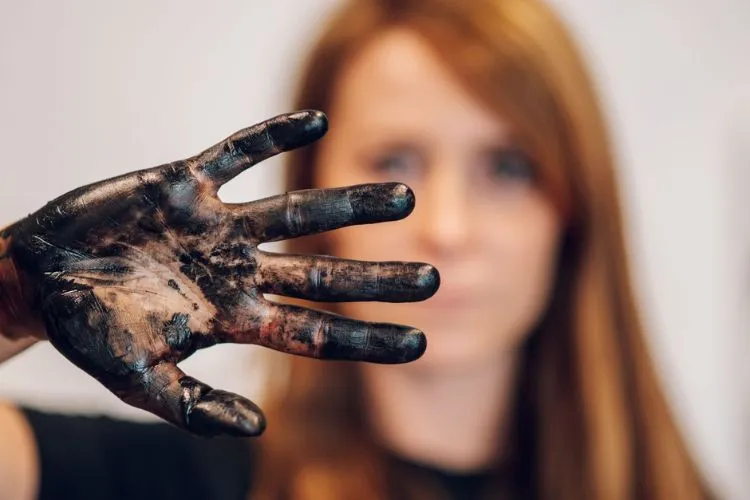Face painting is an art form that brings joy to both children and adults alike. It allows us to transform ourselves into anything we can imagine.
However, when considering acrylic paint for this purpose, one must tread carefully due to safety concerns.
This article will guide you through how to use acrylic paint on your face, highlighting safety precautions, application methods, and removal techniques.

Understanding Acrylic Paint for Face Use
Acrylic paint is loved by artists for its versatility and vibrant colors. Yet, not all acrylic paints are safe for skin contact.
Cosmetic-grade face paints are specifically formulated for skin application, unlike standard acrylic paints found in art stores.
These regular paints may contain harsh chemicals leading to skin reactions. If you decide to use acrylic paints, select non-toxic, hypoallergenic options to minimize risk.
Preparing the Skin
Before you apply any paint, it’s crucial to prepare the skin. Cleanse the face to remove oil, dirt, and other impurities that could affect paint application. Applying a barrier or primer can help protect the skin further.
Choosing the Right Paint
While many brands claim their acrylic paints are non-toxic, not all are suitable for direct skin contact.
It’s vital to conduct a patch test on a small skin area before full application. This step ensures you do not have an adverse reaction to the paint.
How To Use Acrylic Paint On Your Face?
When it comes to application, having the right materials at hand is key. You will need non-toxic acrylic paint, brushes or sponges for application, water for diluting the paint, and a mixing palette.
Application Process
Start by mixing your paints on the palette to get your desired colors. Apply a base layer gently over the skin, ensuring even coverage.
Avoid applying too thickly to prevent cracking. For adding detailed designs, use finer brushes and apply with care.
If needed, setting sprays or powders can help prolong the paint’s appearance.
Safety Precautions

Always keep acrylic paint away from the eyes, inside of the mouth, and open wounds. These areas are sensitive and more prone to irritation or infection.
If an allergic reaction occurs, wash the paint off immediately and seek medical advice if necessary.
Removal Process
Removing acrylic paint from the face needs patience. Use a makeup remover or oil-based product to break down the paint gently.
Applying the remover, let it sit for a few moments, then use a soft cloth or cotton pad to wipe away the paint. Repeat as needed.
Pro Tips
For a lasting application, avoid touching or rubbing the painted areas. Experiment beforehand to perfect your technique and designs.
Mixing paints allows for customization and can lead to unique outcomes. Creative thinking is your best tool when face painting.
Alternatives to Acrylic Paint for Face Painting

While this article focuses on acrylic paints, it’s vital to mention that specific face and body paints are the safest and most appropriate choice for skin use.
These products are formulated with skin health in mind and provide a better option for those looking to explore face painting.
You may also find useful: Can You Use Acrylic Paint On Skin?
Importance of Hydration and Moisturization
Maintaining optimal hydration and moisturization of the skin is crucial when applying and removing acrylic paint from the face.
This ensures that the skin’s barrier remains intact and reduces the risk of irritation or dryness. Before applying paint, use a gentle, hydrating moisturizer suited for your skin type to create a protective layer.
Post-painting, thoroughly cleanse the skin with a mild cleanser to remove all traces of paint, followed by applying a nourishing moisturizer or a hydrating mask to restore moisture balance.
Products containing hyaluronic acid, aloe vera, or glycerin are excellent choices as they draw moisture into the skin and support its natural healing processes. Always prioritize products formulated for sensitive skin to minimize potential reactions.
Tools and Brushes for Application
For a flawless face painting experience with acrylic paints, selecting the right tools and brushes is paramount.
Synthetic bristle brushes are preferred for their smooth application and easy cleanup, while natural bristles may retain moisture and interfere with paint consistency.
A variety of sizes is essential: detail brushes for intricate designs, flat brushes for broader strokes, and fine-tipped brushes for precise lines. Sponges can be used for an even base layer or creating textured effects.
Additionally, mixing palettes and water cups are indispensable for blending custom colors and maintaining brush hygiene.
Opt for ergonomic handles to ensure comfort during long painting sessions, and always choose brushes with soft bristles to protect the delicate skin of the face.

Frequently Asked Questions (FAQs)
Can acrylic paint permanently damage the skin?
No, acrylic paint is unlikely to cause permanent skin damage if used cautiously. However, irritation, allergic reactions, and temporary discomfort are possible.
How long can I safely wear acrylic paint on my face?
It’s best to limit the time you wear acrylic paint on your skin. Remove it as soon as your event or need concludes, usually a few hours.
Are there any brands of acrylic paint that are considered safe for face painting?
While some brands may be non-toxic, it’s crucial to choose products labeled for skin or cosmetic use for safety.
What should I do if I experience a reaction to acrylic paint on my face?
Remove the paint immediately using a gentle cleanser or oil-based remover. If irritation persists, consult a medical professional.
Can I use regular makeup over acrylic paint for added details?
It’s safer to use makeup products specifically made for skin. Combining acrylic paint with makeup might lead to unwanted skin reactions.
Conclusion:
Using acrylic paint on the face can seem like a good idea for those searching for specific colors or effects unavailable in conventional face paints. However, this practice comes with notable risks.
By choosing the correct paint, preparing the skin adequately, applying and removing the paint safely, and following safety tips, you can minimize these risks.
Still, the safest and most recommended route for face painting involves using products specifically designed for skin. Remember, the priority should always be the safety and health of your skin.

Meet Isabella Anderson, your acrylic painting mentor with over a decade of brush-wielding mastery. Dive into the colorful world of acrylics with her expert guidance, featured exclusively on ‘Acrylic Authority.’ Unleash your inner artist and explore the limitless possibilities of this versatile medium alongside a true acrylic aficionado.
